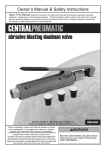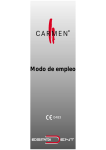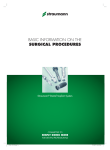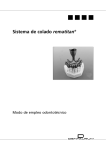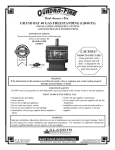Download Titanium Casting Troubleshooting Guide
Transcript
Troubleshooting Guide Titanium Casting ENGLISH Dear Customer Titanium casting is a technique that is now routinely used in many laboratories. But when work becomes routine, it often results in slight carelessness and errors which cause unnecessary problems. This brochure is intended to help you identify and remedy the cause of any problems when casting titanium. This troubleshooting guide does not deal with porcelain facings on titanium frameworks. A separate brochure on porcelain can be obtained gratis from ESPRIDENT, the DENTAURUM subsidiary for porcelain, which also supplies Triceram® bonding porcelain for titanium. (Order no. 989-676-20, Tips for working with Triceram® titanium porcelain) 1 ENGLISH Contents page Rematitan® Plus investment procedure 3–6 Rematitan® Ultra investment procedure 7–11 Preheat furnace temperature check 12 Precast functional check, Autocast, Autocast Plus, Rematitan® casting machines 13 Precast functional check, Castmatic 14 Copper crucibles for Dentaurum titanium casting machines 15 2 ENGLISH Titanium troubleshooting guide Rematitan® Plus investment Problem Cause Remedy Bubbles in the investment mix Insufficient vacuum, inadequate mixing or air evacuation Check vacuum and seals of the vacuum mixer. Adhere to mixing time. Investment sets too rapidly Temperature of the liquid too high Store the mixing liquid all year round in a refrigerator (12°C - 14°C). Measuring beaker used for other liquids (e.g. Rematitan® Ultra) Only use the measuring beaker for Rematitan“ Plus liquid. Drying time too long or temperature too high Fan-assisted drying cabinet: drying time 40 minutes at 70 °C. Then dip in Rematitan cold model hardener for 5 seconds. Dry the model after dipping for 5 minutes at 70 °C. Wax patterns do not adhere to the investment model Too much moisture retained in the model (strong ammonia odour) Non fan-assisted drying cabinet or preheat furnace: 40 minutes at 100 °C. Then dip in Rematitan cold model hardener for 5 seconds. Dry the model after dipping for 5 minutes at 100 °C. Moulds crack during preheating Not adhering to preheat times and temperature Adhere to investment instructions for use. Cools too quickly from 1000 °C to 430 °C e.g. furnace door open or badly sealed furnace Keep the furnace door closed during the cooling phase. Cooling from 1000 °C to 430 °C takes approx. 2.5 – 3 hours. Furnace temperature control faulty Check furnace setting/ thermocouple/control. Furnace temperature too high when inserting moulds Allow the furnace to cool to room temperature. Surface of the investment model (CrCo) powdery after drying or 3 ENGLISH Problem Cause Remedy Moulds crack during preheating Storage temperature of mixing liquid too high Store liquids in a refrigerator all year round (approx. 12 °C -14 °C). CrCo moulds crack during casting Sprue former not positioned in the centre of the casting ring. This causes uneven distribution of pressure during casting. Place the sprue former centrally to the model or reposition the sprue and sprue former. Investment model too thin Model should be 10 –15 mm thick at its deepest point. if necessary, increase the thickness of the model base prior to duplication. Investment too thin around the model Minimum thickness of investment around the model should be 10 mm. Investment too thin over the model Investment thickness should be approx. 30 mm from the residual teeth to the top of the sprue former. Only with Castmatic casting machines: argon pressure set too high. Set the argon pressure on the cylinder pressure gauge to 0.8 bar. CrCo moulds crack during casting, especially with full plates Insufficient investment over full plate model Trim back the distal area of the model up to the wax pattern. Wax the model upright onto the base atan angle of 30°- 45°. Incomplete casting Sprue positioning incorrect Position sprues correctly, see instructions. Insufficient amount of metal Always use 31g or 36g for casting CrCo frameworks. For crowns and bridges up to 6 units 22g, more than 6 units 31g, 14 units 36g. 4 ENGLISH Problem Cause Remedy Incomplete casting Mould and seal not properly centred at the copper crucible throat. The molten metal flows over the seal. This reduces the flow velocity. Press the mould and seal onto the centre of the seal on the copper crucible throat. Seal too old, poor seal Renew the seal. Wax patterns for crowns and bridges positioned too low in the mould The upper edge of the wax pattern should be approx. 8 mm – 10 mm below the rim of the casting ring. Mould cracked See “Moulds crack”. Incorrect pattern thickness Thickness for crown and bridge patterns 0.5 mm, upper CrCo 0.8 – 1 mm, lower CrCo bar 4.3 x 2.3 mm. Molten metal not hot enough: Inclusions in the castings Mould not hot enough Casting temperature of the mould 430 °C Tip of electrode blunt Regrind the electrode to an angle of 50°. Electrode gap incorrect Adjust the electrode gap to 5 mm with a gauge. Crucible over-oxidized, causing a loss of energy Sandblast the crucible with Al2O3, 110 – 125 µm. Mould cracked, resulting in reduced argon pressure and insufficient vacuum. See “Moulds crack”. Insufficient amount of metal Use the correct amount of metal. CrCo casting 31g or 36g, crowns and bridges up to 6 units 22g, more than 6 units 31g, 14 units 36g Incorrect sprue position Adhere exactly to the prescribed sprue position – see instructions for use. 5 ENGLISH Problem Cause Remedy Inclusions in the castings Crucible misshapen due to ageing. The molten metal no longer flows through the centre of the copper crucible throat. Replace the crucible. Mould and seal not fitted in the centre of the seal on the copper crucible throat . Press the mould and seal onto the centre. Molten metal not hot enough: Inaccuracies in fit Tip of electrode blunt Regrind the electrode to an angle of 50°. Electrode gap incorrect Adjust the electrode gap to 5 mm with a gauge. Crowns fit too tightly at the incisal or occlusal Select a suitable spacer for these areas. Vacuumformed foil with spacers are recommended. 6 ENGLISH Titanium troubleshooting guide Rematitan® Ultra investment Problem Cause Remedy Bubbles in the investment mix Inadequate mixing under vacuum Mix for 120 seconds under vacuum. Check the vacuum. Mixture too grainy Mixing time too short. Mix for 120 seconds under vacuum. Investment takes too long to set (longer than 2 hrs). Liquid and powder too cold Temperature of the liquid and powder should be 18° - 21 °C. Setting takes longer if the temperature is less than 18 °C. Mixing liquid and powder contaminated with other investments Use a separate measuring beaker and mixing bowl for Rematitan® Ultra. Base former removed from mould too soon Allow the mould to stand 11/2 - 2 hrs depending on room temperature before placing in the furnace. Metal casting ring not used Use a cylindrical metal casting ring. Use a 1 mm thick ring liner. Size 9 casting ring used Recommended casting ring sizes 3 and 6 Furnace set for weekend Set furnace for overnight. Furnace temperature too high when inserting moulds Allow the furnace to cool to room temperature. Mixing liquid and powder contaminated with other investments Use a separate measuring beaker and mixing bowl for Rematitan® Ultra. Moulds too close to the door or heated walls in the preheat furnace Position as close as possible to the centre of the furnace chamber. Too many moulds in the preheat furnace Fill furnace to max. 2/3 capacity. Moulds crack during preheating 7 ENGLISH Problem Cause Remedy Moulds crack during preheating Wax patterns too close to the casting ring or not enough investment over the pattern Distance between wax pattern and casting ring approx. 6 – 8 mm. Distance from the wax pattern to the top of investment approx. 8 – 10 mm. Ring liner not shortened Shorten the ring liner. Leave a 5 mm area at both ends of the casting ring without ring liner. Ring liner too thick Use a 1 mm thick ring liner. (mineral ring liner, e.g. Kera ring liner) Paper ring liner Use a mineral ring liner. Due to the different types of Calibrate the preheat furnaces, cracks can occur furnace regularly, see despite special batch temperature page 12. and heat soak times. Fan-assisted furnaces: use the same temperature as that given in the batch instructions. Extend the heat soak time gradually by 10 – 30 minutes. Non fan-assisted furnaces: generally increase the temperature given in the batch instructions by 10 °C and gradually increase the heat soak time by 10 – 30 minutes. Incomplete casting Faulty furnace temperature control Calibrate the preheat furnace. Check the accuracy of the temperature, see page 12. Cracked mould See “Moulds crack”. Incorrect pattern thickness Pattern thickness 0.5 mm 8 ENGLISH Problem Cause Incomplete casting Molten metal not hot enough: Mould not hot enough Inaccuracies in fit Remedy Casting temperature of the mould 430 °C. Tip of electrode blunt Regrind the electrode to an angle of 50°. Electrode gap incorrect Adjust the electrode gap to 5 mm with a gauge. Crucible over-oxidized, causing a loss of energy Sandblast the crucible with Al2O3, 110 – 125 µm. Inadequate regulation of expansion Increased expansion = looser fit Increase the final batch temperature in 10 °C stages or extend the heat soak time at the final temperature in 10 minute stages. Lower expansion = tighter fit Reduce the final batch temperature in 10 °C stages or reduce the heat soak time in 10 minute stages. Caution If the final temperature or heat soak time is reduced too much, the investment may become unstable (cracking). Casting surfaces not clean Moulds too close to the door or heated walls in the preheat furnace Position as close as possible to the centre of the furnace chamber. Wax not burning out without residue Use organic wax which burns out without residue, e.g. Star wax, Dentaurum. 9 ENGLISH Problem Cause Remedy Casting surfaces not clean Wrong wetting agent Use Lubrofilm wetting agent. Inclusions in the castings Mould is cracked in the area of the sprue former when removed from the preheat furnace. Ensure the moulds are positioned securely. Fan-assisted furnaces: use the same temperature as that given in the batch instructions. Extend the heat soak time gradually by 10 – 30 minutes. Non fan-assisted furnaces: generally increase the temperature given in the batch instructions by 10 °C and gradually extend the heat soak time by 10 – 30 minutes. Generally the preheat temperature of 250 °C/ 90 min. and the casting temperature of 430 °C/ 30 min. remain the same. Heat rate 3 - 5 °C per minute. Sprue not positioned according to instructions See "Sprue positioning instructions”. Top of the mould not cut back Cutting back the top of the mould allows gas to escape more easily and increases thermal stability. Do not use a trimmer! Seal not optimal when the mould is pressed against the seal of the copper crucible throat Check the seal. Ensure that the mould is pressed flat. Insufficient amount of metal Crowns and bridges up to 6 units 22g, more than 6 units 31g, 14 units 36g. 10 ENGLISH Problem Inclusions in the castings Cause Remedy Crucible misshapen due to ageing. The molten metal no longer flows through the centre of the copper crucible throat. Replace the crucible. Molten metal not hot enough: Tip of electrode blunt Regrind the electrode to an angle of 50°. Electrode gap incorrect Adjust the electrode gap to 5 mm with a gauge. 11 ENGLISH Preheat furnace temperature check – basic requirement for the correct use of Rematitan® Ultra investment Rematitan® Ultra titanium investment requires very accurate temperature regulation to provide the benefits of its excellent properties. A fan-assisted preheat furnace heated on four sides, such as the Protherm from Dentaurum (Order no. 096-180-00), is recommended. The procedure for checking the (actual) temperature reached by the preheat furnace is as follows: 1. Place a piece of pure silver wire approx. 10 mm long (goldsmith or silversmith) on an old porcelain support tray and insert it in the preheat furnace. Set the final temperature to 955 °C and heat up the furnace. Check the wire after holding the temperature for 30 minutes. The wire should not yet be ballshaped. 2. Now set the temperature to 965 °C and wait another 30 minutes. Since the melting point of silver is 961 °C, the silver should now be ball-shaped if the furnace temperature is correct. 3. If the silver wire is still in the form of a wire, checks should be continued in stages of 10 °C with a holding time of 30 minutes. The resulting temperature difference on the furnace control should be taken into account in future when setting the final furnace temperature for the investment. ☞ A check should be carried out every 6 months, as the furnace coils age relatively quickly. 12 ENGLISH Precast functional check Autocast, Autocast Plus, Rematitan 1. Check that the chamber and copper crucible are clean and free of titanium residue. 2. Check the tip of the tungsten electrode. If the tip is blunt, regrind to an angle of 50° using a tungsten carbide cutter. 3. Check the distance to the electrode with a gauge. The distance between the tip of the electrode and the titanium ingot should be 5 mm. 4. Check the copper crucible. Sandblast the oxide layer away completely after 3 castings using Al2O3, grit size 110 – 125 µm. Preparing for casting 5. Open the argon cylinder and check the level and cylinder pressure. 6. Switch to “ON”. 7. Insert the crucible. 8. Position the titanium ingot on the crucible. 9. Enter the weight of the titanium ingot in the casting machine. 10. Press the mould and seal onto the seal of the copper crucible. 11. Check that the mould is pressed onto the centre. 12. Close the door. 13. Press “Start”. 14. The programme is fully automated. 15. The programme is complete when both manometer indicators are at “0” (Autocast, Autocast Plus). 16. Open the door, remove the mould and quench it with water. 17. Remove the crucible and quench it with water. 18. Switch to “Off”. 19. Close the argon cylinder. P.S.: Information about the maintenance of your casting machine is included in the instructions for use supplied with the casting machine. 13 ENGLISH Precast functional check - Castmatic 1. 2. 3. 4. 5. 6. 7. 8. 9. 10. 11. 12. 13. 14. 15. 16a. 16b. 17a. 17b. 18. Open the argon cylinder. Switch to “ON”. Set the power control to 10. Check both chambers to ensure that they are clean (titanium residue on the tip of the electrode). Check that the clamp in the upper chamber moves easily. Insert the crucible carrier and crucible and ensure the markings are correctly placed. Insert the ingot and set the electrode tip gap to 5 mm using a gauge (unscrew and tighten the grub screw with an Allen key). Enter the melting times. 22 g = 28 sec. 31 g = 38 sec. 36 g = 42 sec. Remove the crucible carrier, crucible and ingot from the upper chamber again. Insert the mould with the seal in position in the lower chamber and raise the lift to grip the mould (do not exert too much pressure). Check the access from the upper to the lower chamber - is the sprue hole in line with the crucible throat? Insert the crucible carrier, crucible and ingot and close the doors. Press “Start”. The casting procedure is automatic. The yellow indicator should show 0.75 – 0.78 and the white indicator plus 0.8 bar. If the yellow indicator drops to 0, the mould is not sealed (cracks or incorrect programme entered). Remedy: - switch off - open the door - check the mould - press once again - close the door - turn the dial to zero and re-enter the required melting time - press “Start” After flooding both chambers to zero, open the door, lower the lift, remove the mould and quench it immediately. Remove the crucible and quench it immediately. If the crucible throat and sprue button are connected, do not use force to remove the mould. Remove the lower spacer and turn the mould to remove it from the chamber. Remove any residual titanium from the crucible and blow dry. If the residue in the crucible does not loosen, do not try to remove it with an instrument. Loosen by lightly tapping the back edge of the titanium residue. Remove any titanium still adhering to the crucible with a rubber polisher. Further castings and checks as from 4. 14 ENGLISH Copper crucibles for Dentaurum titanium casting machines • Order no. 090-110-00 for Rematitan® and Rematitan® Autocast • Order no. 090-010-00 for Castmatic These procedures should be followed to ensure the best results from the crucible: ☞ Always use dry, clean crucibles for casting. ☞ Sandblast oxidised crucibles in the sandblaster (with Al2O3, 110 – 250 µm). ☞ Always use original Rematitan® ingots. ☞ Place the ingot on the crucible according to the positioning zones (see instructions for use for the casting machine). ☞ Place the crucible correctly in the crucible carrier (see instructions for use). ☞ Adhere to the melting times for the different weights of ingot: Casting weight: 22 g 31 g 36 g castmatic: 28 s 38 s 42 s rematitan®: 29 s 40 s 46 s autocast: 32 s 43 s 49 s Note: The condition of the electrode and the electrode gap also affect the melting process, which in turn affects the thermal stress on the crucible. We therefore recommend: ☞ checking the electrode gap with a gauge and centring correctly ☞ checking the electrode tip ☞ sandblasting the oxidized electrode Extended melting times result in the crucible overheating and delay ☞ Always remove the crucible immediately after use and quench it in cold water. ☞ Do not allow titanium residue to cool on the crucible. ☞ Do not throw or hit the crucible. ☞ Do not use force to remove titanium residue sticking to the crucible. Loosen by lightly tapping the back edge of the titanium residue. ☞ Use a rubber polisher to remove any titanium residue adhering to the crucible. ☞ Replace worn or cracked crucibles. 15 Turnstraße 31 · 75228 Ispringen · Germany Phone +49 72 31/803-0 · Fax +49 72 31/80 32 95 www.dentaurum.com · E-Mail: [email protected] 989-845-20 Printed by Dentaurum Germany 10/02 Stand of the Information: 10/01


















